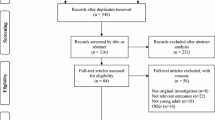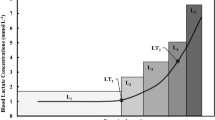Abstract
This study investigated cycling performance and oxygen uptake \(( \dot{V}{\text{O}}_{ 2} )\) kinetics between upright and two commonly used recumbent (R) postures, 65°R and 30°R. On three occasions, ten young active males performed three bouts of high-intensity constant-load (85% peak-workload achieved during a graded test) cycling in one of the three randomly assigned postures (upright, 65°R or 30°R). The first bout was performed to fatigue and second and third bouts were limited to 7 min. A subset of seven subjects performed a final constant-load test to failure in the supine posture. Exercise time to failure was not altered when the body inclination was lowered from the upright (13.1 ± 4.5 min) to 65°R (10.5 ± 2.7 min) and 30°R (11.5 ± 4.6 min) postures; but it was significantly shorter in the supine posture (5.8 ± 2.1 min) when compared with the three inclined postures. Resulting kinetic parameters from a tri-exponential analysis of breath-by-breath \( \dot{V}{\text{O}}_{ 2} \) data during the first 7 min of exercise were also not different between the three inclined postures. However, inert gas rebreathing analysis of cardiac output revealed a greater cardiac output and stroke volume in both recumbent postures compared with the upright posture at 30 s into the exercise. These data suggest that increased cardiac function may counteract the reduction of hydrostatic pressure from upright ~25 mmHg; to 65°R ~22 mmHg; and 30°R ~18 mmHg such that perfusion of active muscle presumably remains largely unchanged, and also therefore, \( \dot{V}{\text{O}}_{ 2} \) kinetics and performance during high-intensity cycling.




Similar content being viewed by others
References
Barstow TJ, Mole PA (1991) Linear and nonlinear characteristics of oxygen uptake kinetics during heavy exercise. J Appl Physiol 71:2099–2106
Beaver WL, Wasserman K, Whipp BJ (1986) A new method for detecting anaerobic threshold by gas exchange. J Appl Physiol 60:2020–2027
Bundle MW, Ernst CL, Bellizzi MJ, Wright S, Weyand PG (2006) A metabolic basis for impaired muscle force production and neuromuscular compensation during sprint cycling. Am J Physiol Regul Integr Comp Physiol 291:R1457–R1464
Burnley M, Doust JH, Jones AM (2006) Time required for the restoration of normal heavy exercise VO2 kinetics following prior heavy exercise. J Appl Physiol 101:1320–1327
Convertino VA, Goldwater DJ, Sandler H (1984) Oxygen uptake kinetics of constant-load work: upright vs supine exercise. Aviat Space Environ Med 55:501–506
Denis R, Perrey S (2006) Influence of posture on pulmonary O2 uptake kinetics, muscle deoxygenation and myolectrical activity during heavy-intensity exercise. J Sports Sci Med 5:254–265
Egaña M, Green S (2005) Effect of body tilt on calf muscle performance and blood flow in humans. J Appl Physiol 98:2249–2258
Egaña M, Green S (2007) Intensity-dependent effect of body tilt angle on calf muscle fatigue in humans. Eur J Appl Physiol 99:1–9
Egaña M, Green S, Garrigan EJ, Warmington S (2006) Effect of posture on high-intensity constant-load cycling performance in men and women. Eur J Appl Physiol 96:1–9
Egaña M, Smith S, Green S (2007) Revisiting the effect of posture on high-intensity constant-load cycling performance in men and women. Eur J Appl Physiol 99:495–501
Eiken O (1988) Effects of increased muscle perfusion pressure on responses to dynamic leg exercise in man. Eur J Appl Physiol Occup Physiol 57:772–776
Faisal A, Beavers KR, Robertson AD, Hughson RL (2009) Prior moderate and heavy exercise accelerate oxygen uptake and cardiac output kinetics in endurance athletes. J Appl Physiol 106:1553–1563
Fitzpatrick R, Taylor JL, McCloskey DI (1996) Effects of arterial perfusion pressure on force production in working human hand muscles. J Physiol 495(Pt 3):885–891
Folkow B, Haglund U, Jodal M, Lundgren O (1971) Blood flow in the calf muscle of man during heavy rhythmic exercise. Acta Physiol Scand 81:157–163
Hughson RL, Xing HC, Borkhoff C, Butler GC (1991) Kinetics of ventilation and gas exchange during supine and upright cycle exercise. Eur J Appl Physiol Occup Physiol 63:300–307
Hughson RL, Cochrane JE, Butler GC (1993) Faster O2 uptake kinetics at onset of supine exercise with than without lower body negative pressure. J Appl Physiol 75:1962–1967
Hughson RL, Shoemaker JK, Tschakovsky ME, Kowalchuk JM (1996) Dependence of muscle VO2 on blood flow dynamics at onset of forearm exercise. J Appl Physiol 81:1619–1626
Jacobs PL, Nash MS (2004) Exercise recommendations for individuals with spinal cord injury. Sports Med 34:727–751
Jakovljevic DG, Nunan D, Donovan G, Hodges LD, Sandercock GR, Brodie DA (2008) Comparison of cardiac output determined by different rebreathing methods at rest and at peak exercise. Eur J Appl Physiol 102:593–599
Jones AM, Berger NJ, Wilkerson DP, Roberts CL (2006) Effects of “priming” exercise on pulmonary O2 uptake and muscle deoxygenation kinetics during heavy-intensity cycle exercise in the supine and upright positions. J Appl Physiol 101:1432–1441
Koga S, Shiojiri T, Shibasaki M, Kondo N, Fukuba Y, Barstow TJ (1999) Kinetics of oxygen uptake during supine and upright heavy exercise. J Appl Physiol 87:253–260
Leyk D, Essfeld D, Hoffmann U, Wunderlich HG, Baum K, Stegemann J (1994) Postural effect on cardiac output, oxygen uptake and lactate during cycle exercise of varying intensity. Eur J Appl Physiol Occup Physiol 68:30–35
Lutjemeier BJ, Miura A, Scheuermann BW, Koga S, Townsend DK, Barstow TJ (2005) Muscle contraction–blood flow interactions during upright knee extension exercise in humans. J Appl Physiol 98:1575–1583
MacDonald MJ, Shoemaker JK, Tschakovsky ME, Hughson RL (1998) Alveolar oxygen uptake and femoral artery blood flow dynamics in upright and supine leg exercise in humans. J Appl Physiol 85:1622–1628
Moritani T, Sherman WM, Shibata M, Matsumoto T, Shinohara M (1992) Oxygen availability and motor unit activity in humans. Eur J Appl Physiol Occup Physiol 64:552–556
Moritani T, Takaishi T, Matsumoto T (1993) Determination of maximal power output at neuromuscular fatigue threshold. J Appl Physiol 74:1729–1734
Perell KL, Gregor S, Kim G, Rushatakankovit S, Scremin E, Levin S, Gregor R (2002) Comparison of cycling kinetics during recumbent bicycling in subjects with and without diabetes. J Rehabil Res Dev 39:13–20
Reiser RF 2nd, Maines JM, Eisenmann JC, Wilkinson JG (2002) Standing and seated Wingate protocols in human cycling. A comparison of standard parameters. Eur J Appl Physiol 88:152–157
Shiotani I, Sato H, Yokoyama H, Ohnishi Y, Hishida E, Kinjo K, Nakatani D, Kuzuya T, Hori M (2002) Muscle pump-dependent self-perfusion mechanism in legs in normal subjects and patients with heart failure. J Appl Physiol 92:1647–1654
Tachi M, Kouzaki M, Kanehisa H, Fukunaga T (2004) The influence of circulatory difference on muscle oxygenation and fatigue during intermittent static dorsiflexion. Eur J Appl Physiol 91:682–688
Terkelsen KE, Clark AL, Hillis WS (1999) Ventilatory response to erect and supine exercise. Med Sci Sports Exerc 31:1429–1432
Welbergen E, Clijsen LP (1990) The influence of body position on maximal performance in cycling. Eur J Appl Physiol Occup Physiol 61:138–142
Acknowledgments
The experiments presented in the present study comply with the current laws of the Republic of Ireland.
Conflict of interest statement
The authors of the present study declare that they have no conflict of interest.
Author information
Authors and Affiliations
Corresponding author
Additional information
Communicated by Susan Ward.
Rights and permissions
About this article
Cite this article
Egaña, M., O’Riordan, D. & Warmington, S.A. Exercise performance and \( \dot{V}{\text{O}}_{ 2} \) kinetics during upright and recumbent high-intensity cycling exercise. Eur J Appl Physiol 110, 39–47 (2010). https://doi.org/10.1007/s00421-010-1466-y
Accepted:
Published:
Issue Date:
DOI: https://doi.org/10.1007/s00421-010-1466-y




